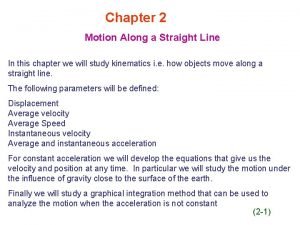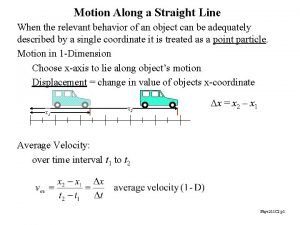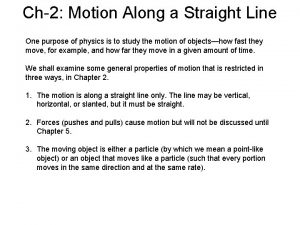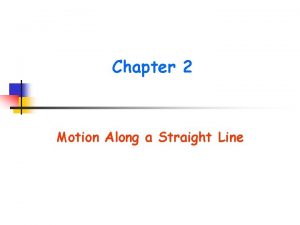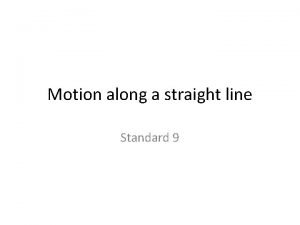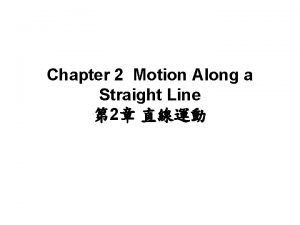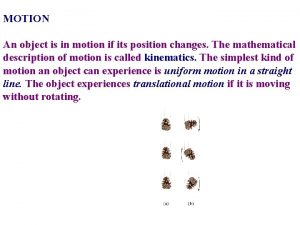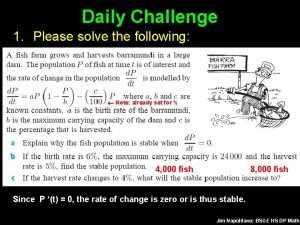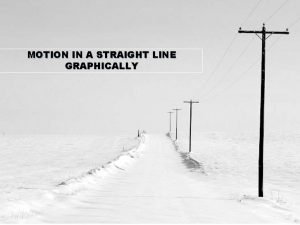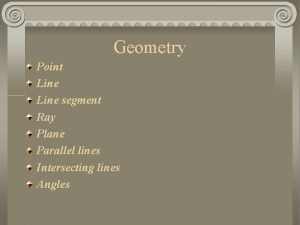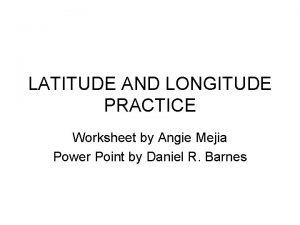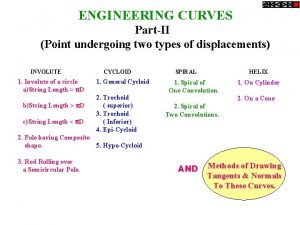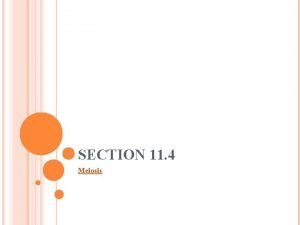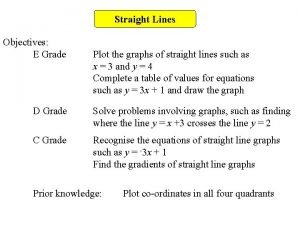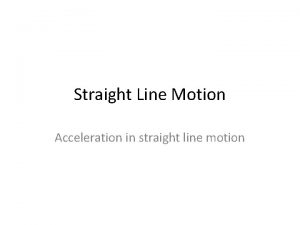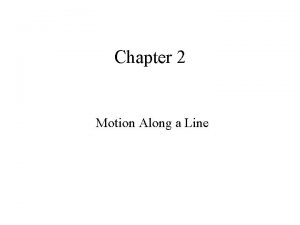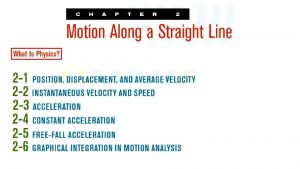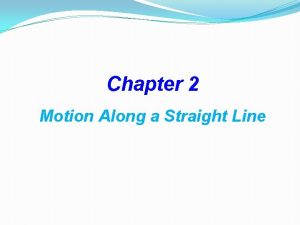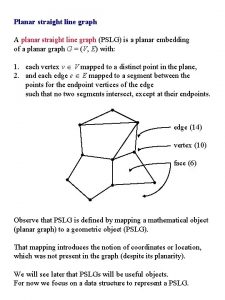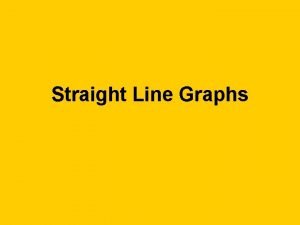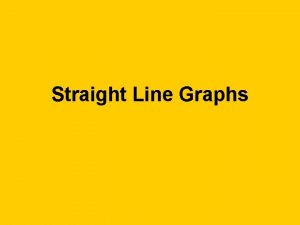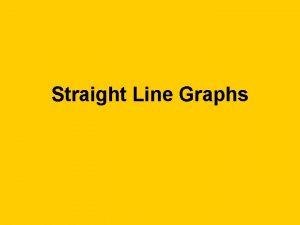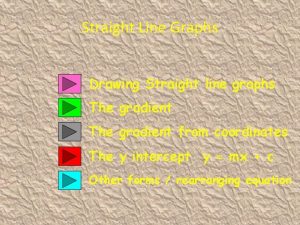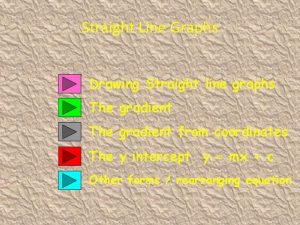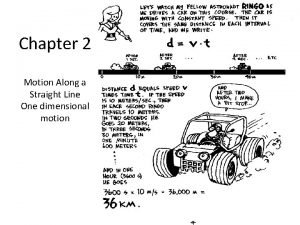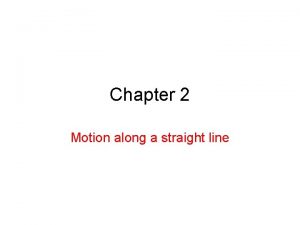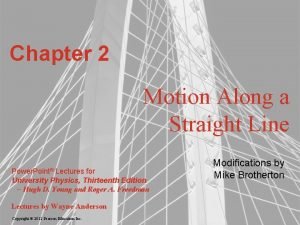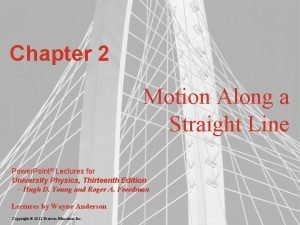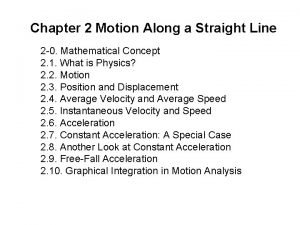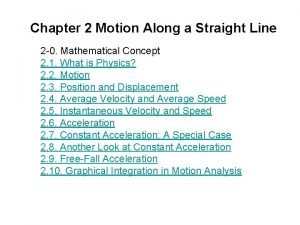Chapter 2 Motion Along a Straight Line Motion



















- Slides: 19

Chapter 2 Motion Along a Straight Line

Motion Along a Straight Line n n In this chapter we will study kinematics, i. e. , how objects move along a straight line. The following parameters will be defined: Displacement Average velocity Average speed Instantaneous velocity Average and instantaneous acceleration n For constant acceleration we will develop the equations that give us the velocity and position at any time. n we will study the motion under the influence of gravity close to the surface of the Earth. n Finally, we will study a graphical integration method that can be used to analyze the motion when the acceleration is not constant.

Ch 2 -1 Motion Along a Straight Line n v v n n Motion of an object along a straight line Object is point mass Motion along a horizontal or vertical or inclined (line with finite slope) line Motion: Change in position No change in position, body at rest

Ch 2 -3 Position and Displacement v v v Axis are used to define position of an object Position of an object defined with respect to origin of an axis Position x of an object is its distance from the origin at any time t Displacement x, a vector, is change in position. v x = xf-xi When an object changes its position, it has a velocity

Check Point 2 -1 v v Here are three pairs of initial and final positions, respectively along x axis. Which pair give a negative displacement? a) -3 m, + 5 m b) -3 m, -7 m c) 7 m, -3 m § § Ans: x=xf-xi a) x=xf-xi=5 -(-3)=+8 b) x=xf-xi=-7 -(-3)=-4 c) x=xf-xi=-3 -(+7)=-10 ü Ans: b and c

Ch 2 -4 Average Velocity, Average Speed v v v v v Average Velocity vavg= x/ t vavg = (xf-xi) /(tf-ti)=Dispalcemnt/time Average speed Savg: a scalar Savg = total distance/ total time Instantaneous Velocity v: v= lim ( x/ t) t 0 Position-time graph used to define object position at any time t and to calculate its velocity v is slope of the line on positiontime graph

Check Point 2 -3 v v v v The following equations give the position x(t) of a particle in four situations ( in each equation , x is in meters, t is in seconds, and t>0): 1) x = 3 t-2 2) x=-4 t 2 -2 3) x= 2/t 2 4) x=-2 a) In which situation velocity v of the particle constant? b) In which v is in the negative direction? Ans: v=dx/dt 1) v=+3 m/s 2) v=-8 t m/s 3) v = -4/t 3 4) v=0 v v v a) 1 and 4 c) 2 and 3

Ch 2 -6 Acceleration v v v When an object changes its velocity, it undergoes an acceleration Average acceleration aavg = v/ t = (vf-vi) /(tf-ti) Instantaneous acceleration a: a= lim ( v/ t) t 0 = dv/dt=d 2 x/dt 2 Velocity-time graph used to define object velocity at any time t and calculate its acceleration a is slope of the line on velocity -time graph

Ch 2 -6 Acceleration If the sign of the velocity and acceleration of a particle are the same, the speed of particle increases. v If the sign are opposite, the speed decreases. v

Check Point 2 -4 v A wombat moves along an x axis. What is the sign of its acceleration if it is moving: v a) in the positive direction with increasing speed, v b) in the positive direction with decreasing speed v c) in the negative direction with increasing speed, v d) in the negative direction with decreasing speed? Ans: a) b) c) d) plus minus plus

Ch 2 -7 Constant Acceleration F F F Motion with constant acceleration has : Variable Slope of positiontime graph Constant Slope of velocity time graph Zero Slope of acceleration time graph For constant acceleration a =aavg= (vf-vi)/(tf-ti) vavg= (vf+vi)/2

Equations for Motion with Constant Acceleration v=v 0+at v x-x 0=v 0 t+(at 2)/2 v v 2=v 02+2 a(x-x 0) v x-x 0=t(v+v 0)/2 v x-x 0 =vt-(at 2)/2 v

Check Point 2 -5 q 1) 2) 3) 4) q The following equations give the position x(t) of a particle in four situations: x=3 t-4 x=-5 t 3+4 t 2+6 x=2/t 2 -4/t x=5 t 2 -3 To which of these situations do the equations of Table 2 -1 apply? Ans: Table 2 -1 deals with constant acceleration case hence calculate acceleration for each equation: 1) a = d 2 x/dt 2=0 2) a = d 2 x/dt 2=-30 t+8 3) a = d 2 x/dt 2 = 12/t 4 -8/t 2 4) a = d 2 x/dt 2 = 10 ü Ans: 1 and 4 ( constant acceleration case)

Ch 2 -9 Free Fall Acceleration v v Free fall acceleration ‘g’ dde to gravity g directed downward towards Earth’s center along negative y-axis with a = -g = -9. 8 m/s 2 equations of motion with constant acceleration are valid for free fall motion

Check Point 2 -6 a) What is the sign of the ball’s displacement for the ascent, from the release point to the highest point? B) What is it for the descent , from the highest point back to to the release point c) What is the ball’s acceleration at its highest point? a) (a) plus (upward displacement on y axis); (b) minus (downward displacement on y axis); (c) a = −g = − 9. 8 m/s 2

Ch 2 -10 Graphical Integration in Motion Analysis v v v Integration of v-t graph to obtain displacement x x =x-x 0=vt = v dt but v dt= area between velocity curve and time axis from t 0 to t Integration of a-t graph to obtain velocity v Similarly v =v-v 0= a dt = area between acceleration curve and time axis from t 0 to t

Old examples Which of the following statements is WRONG? A) A body can have constant velocity and still have a varying speed. Not Possible B) A body can have a constant speed and still have a varying velocity. uniform circular motion C) A body can have zero velocity and still be accelerating. free fall at max. height D) A body can have a constant acceleration and a variable velocity. by definition E) A body can have an upward velocity while experiencing a downward acceleration. free fall

Old examples n FIGURE 1 shows the motion of a particle moving along an x axis with constant acceleration. What is the magnitude of the acceleration of the particle? n n n n A) 4 m/s 2 B) 6 m/s 2 C) 3 m/s 2 D) 2 m/s 2 E) 5 m/s 2 Ans: x 0=x(0)= − 2 m x−x 0=v 0 t+ 12 at 2 x+2=v 0 t+ 12 at 2

Two cars are initially at rest. Car A is at x = 0, and car B is at x = + 600 m. They start to move, at the same time, along the same line in the positive x direction with constant accelerations: a. A = 4. 00 m/s 2 and a. B = 1. 00 m/s 2. How long does it take car A to overtake car B? A) 20. 0 s B) 30. 0 s C) 25. 0 s D) 34. 5 s E) 17. 5 s Ans: Let d 1=distance moved by A Let d 2=distance moved by B When they meet: d 1= d 2+ 600 �(1) d 2= v 0 t+ 12 a. Bt 2=12× 1. 00×t 2= 12 t 2 �(3) From (2)and (3), back to (1): 2 t 2=12 t 2+600 ⇒ 32 t 2=600 t 2= 23× 600=400 ⇒t=20. 0 s
 Motion along a line
Motion along a line Chapter 2 motion along a straight line
Chapter 2 motion along a straight line Motion along a straight line definition
Motion along a straight line definition Motion along a straight line definition
Motion along a straight line definition It is a motion along a straight line
It is a motion along a straight line Graph of uniform motion
Graph of uniform motion Motion along a line
Motion along a line An object travels back and forth along a straight line
An object travels back and forth along a straight line Difference between speed and velocity class 9
Difference between speed and velocity class 9 Straight line motion revisited homework
Straight line motion revisited homework Straight line motion equations
Straight line motion equations Collection of points along a straight path
Collection of points along a straight path Representative fraction
Representative fraction Longitude and latitude practice worksheet
Longitude and latitude practice worksheet Classification of engineering curves
Classification of engineering curves Fold back the paper along the dotted line
Fold back the paper along the dotted line Stages of prophase in meiosis
Stages of prophase in meiosis Light travels in a straight line worksheet
Light travels in a straight line worksheet Straight line ppc
Straight line ppc Plotting straight line graphs tes
Plotting straight line graphs tes
